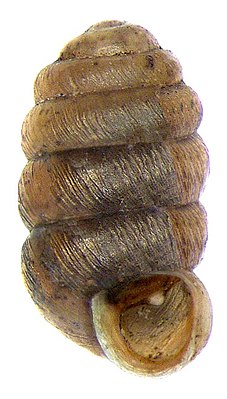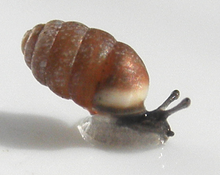Moss snail
| Moss snail | ||||||||||||
|---|---|---|---|---|---|---|---|---|---|---|---|---|

Moss snail ( Pupilla muscorum ) |
||||||||||||
| Systematics | ||||||||||||
|
||||||||||||
| Scientific name | ||||||||||||
| Pupilla muscorum | ||||||||||||
| ( Linnaeus , 1758) |
The moss dolls screw ( Pupilla muscorum ), also moss dolls screw or Moss doll called, is a snail from the family of pupillidae that the subordination of terrestrial snails is expected (gastropod).
features
The housing are 3 to 4 mm thick and 1.65 to 1.75mm in diameter quite small. It is cylindrical in shape with a rounded apex . The five to seven whorls are slightly arched on the periphery, the seam relatively shallow. The last contact is often a little lower than the penultimate contact. Drought and very calcareous soils are correlated in some areas with smaller, thicker and more strongly toothed shells. The case varies somewhat in length-width ratio and in the curvature of the passageways.
The mouth is rounded with a thickened, but little turned-up, edge of the mouth. A strong, whitish, dam-shaped neck bulge is formed, which is set off from the edge of the mouth by a groove-shaped depression. The mouth is occasionally not dentate, but there is often a small, callous parietal tooth. In more strongly toothed specimens there are up to three teeth, in addition to the (mostly present) parietal tooth, a columellar and a lower palatal tooth. The shell is relatively thick and slightly translucent. The outside of the case is almost smooth or only very fine and irregularly striped, not shiny, and colored brown to reddish brown. In the case of adult specimens, the housing is often already slightly weathered and therefore gray-white.
The animal is small, the soft body is darkly colored with slightly lighter sides and a lighter foot. The upper tentacles are moderately long, the lower tentacles are quite short.
In the hermaphroditic genital apparatus, the spermatic duct (vas deferens) branches off early from the egg duct (sperm duct). It is slightly twisted and enters the epiphallus apically . This is relatively long, about as long as the penis. A short, conical blind sack is formed at the epiphallus / penis transition. The very long, articulated appendix starts in the lower half of the penis. The lower third of the appendix is thick, the upper two-thirds thin, the upper end elongated club-shaped thickened. The penile retractor muscle divides into two strands that attach to the epiphallus and the end of the thickened third of the penile appendix. The free fallopian tube (oviduct) is about as long or slightly shorter than the vagina. The stem of the spermathec is very thin, the bladder barely formed. Shortly before the end, a short diverticulum begins. The animals are oviviviparous; in pregnant specimens, the spermoviduct acts as a uterus and is very distended. The male parts of the sexual apparatus are regressed and reduced to thread-like structures.
Similar species
The moss snail is very difficult to differentiate from the wet meadow snail . Molecular genetic, ecological and housing morphological characteristics together, however, allow a reliable distinction between the two species. The wet meadow snail is slightly larger (higher) and wider than the moss snail and has more and usually more arched coils with deeper seams. It has a thinner, darker shell, and the strips of growth are somewhat coarser than those of the moss snail. The mouth lip is a little less developed, and the mouth teeth are usually less developed in the wet meadow pupa snail and attach directly to the housing wall, not from a callus, as is sometimes the case with the moss pupa snail. Especially in specimens of wet meadow snail from Scandinavia, the teeth are often completely missing. The habitat of the two species is different, wet meadows with the wet meadow pupa snail, dry locations with the moss pupa snail. In the case of the two-toothed doll snail , the whorls are slightly more rounded at the periphery, the seams a little deeper. The species is also on average smaller than Pupilla muscorum and slightly less striped. The striped pupa snail ( Pupilla sterrii ) is clearly more or more coarsely striped.
Geographical distribution and habitat
The distribution area is moss pupa snail is Holarctic and can be found in almost Europe (with the exception of the extreme north). There is also evidence from Northwest Africa. In 2009 the species was also detected in Northern Pakistan.
The animals prefer to settle on chalky subsoil, but also on basalt subsoil, on dry locations such as dry grass, dry stone walls and scree fields. It is also found in dry coastal dunes. In the Alps it rises up to 2400 m above sea level, in Bulgaria up to 1200 m. It was found in northern Pakistan at altitudes up to 2550 m above sea level. There they often live in large numbers in the sludge under the leaf litter, under dead plants, in the moss, or between the roots of the plants growing there.
Way of life
The animals are ovoviviparous and carry eggs and embryos all year round. During this time, the spermoviduct contains one to eight embryos (on average: 2 to 6), very rarely up to 10 embryos. The embryos are usually in different stages of development, with the embryos being most developed in the lower part of the spermoviduct, very rarely are the embryos at the same stage of development, but only if there are few embryos (1 to 2, rarely 3). If there were three or more embryos in the spermoviduct, the embryos were almost always in different stages of development. In Poland, the main phase in which the fully developed embryos were released was from June to August, in France from July to September. Sexual maturity is probably only reached in the second or third year. The animals presumably die after the reproductive period. When the animals carry eggs and embryos, they no longer copulate and the male ducts are reduced to thread-like structures.
The animals mainly eat withered, rotting leaves, i.e. dead plant material, only rarely do they eat green leaves.
Taxonomy
The taxon was first validly described as Turbo muscorum by Carl von Linné in the context of zoological nomenclature as early as 1758 . It is de facto the type species of the genus Pupilla Fleming, 1828, since the pro forma type species Pupa marginata Draparnaud, 1801 is a younger synonym of Pupa muscorum Linnaeus, 1758. Fauna Europa has four synonyms: the aforementioned Pupa marginata Draparnaud, 1801, Pupa elongata Clessin, 1876, Pupa emigrata Westerlund, 1897 and Pupilla transsylvanica Kimakowicz, 1890 and Pupilla l'eprevieri Pallary, 1928.
Danger
The populations of the species are declining in many regions. The species is therefore on the warning list in Germany. In other regions, stocks are also declining, for example in Great Britain due to the intensive use of old meadows on chalky subsoil. The species is already endangered in Vorarlberg. The (IUCN) classifies them as not at risk overall.
supporting documents
literature
- Klaus Bogon: Land snails biology, ecology, biotope protection. Natur Verlag, Augsburg 1990, ISBN 3-89440-002-1 (pp. 134, 136).
- Rosina Fechter and Gerhard Falkner: molluscs. 287 p., Mosaik-Verlag, Munich 1990 (Steinbach's Nature Guide 10), ISBN 3-570-03414-3 (p. 148)
- Ewald Frömming: Biology of the Central European Landgastropods. 404 p., Duncker & Humblot, Berlin 1954 (p. 36–38)
- Alexandru V. Grossu: Gastropoda Romaniae 2 Subclasa Pulmonata I Ordo Basommatophora II Ordo Stylommatophora Suprafamiliile: Succinacea, Cochlicopacea, Pupillacea. 443 S., Bucharest 1987 (pp. 312-313).
- Jürgen H. Jungbluth and Dietrich von Knore: Trivial names of land and freshwater mollusks in Germany (Gastropoda et Bivalvia). Mollusca, 26 (1): 105–156, Dresden 2008, ISSN 1864-5127 (p. 116)
- Michael P. Kerney, RAD Cameron & Jürgen H. Jungbluth: The land snails of Northern and Central Europe. 384 pp., Paul Parey, Hamburg & Berlin 1983, ISBN 3-490-17918-8 (p. 118)
- Francisco W. Welter-Schultes: European non-marine molluscs, a guide for species identification = identification book for European land and freshwater mollusks. A1-A3 S., 679 S., Q1-Q78 S., Planet Poster Ed., Göttingen 2012, ISBN 3-933922-75-5 , ISBN 978-3-933922-75-5 (hereinafter Welter-Schultes, Identification book, page number)
- Vollrath Wiese: Germany's land snails. 352 p., Quelle & Meyer, Wiebelsheim 2014 ISBN 978-3-494-01551-4 (hereinafter meadow, land snails, page number)
On-line
Individual evidence
- ↑ Alexandru V. Grossu: Gastropoda Romaniae 2 Subclasa Pulmonata I Ordo Basommatophora II Ordo Stylommatophora Suprafamiliile: Succinacea, Cochlicopacea, Pupillacea. 443 S., Bucharest 1987 (pp. 312-313).
- ↑ a b M. B. Seddon, DT Holyoak: Land gastropoda of NW. Africa. New distributional data and nomenclature. Journal of Conchology, 34: 311-323, 1993 abstract
- ↑ a b Beata M. Pokryszko, Kurt Auffenberg, Jaroslav Č. Hlaváč, Fred Naggs: Pupilloidea of Pakistan (Gastropoda: Pulmonata): Truncatellininae, Vertigininae, Gastrocoptinae, Pupillinae (In Part). Annales Zoologici, 59 (4): 423-458, 2009 doi : 10.3161 / 000345409X484847
- ↑ Beata Pokryszko: Observations on seasonal dynamics of age structure and reproduction of Pupilla muscorum L. (Gastropoda: Pulmonata: Pupillidae). Folia Malacologica 9 (1): 45-50, 2001 PDF .
- ↑ Carolus Linnaeus: Systema naturae per regna tria naturae, secundum classes, ordines, genera, species, cum characteribus, differentiis, synonymis, locis. Tomus I. Editio decima, reformata. 824 S., Salvius, Holmiae / Stockholm, 1758 near Göttingen Digitization Center (p. 767)
- ↑ Fauna Europaea
- ↑ Wiese, Landschnecken, p. 104.
- ↑ Welter-Schultes, Identification Book, p. 131.
- ↑ Pupilla muscorum in the IUCN Red List of Threatened Species 2013.2. Posted by: Neubert, E., 2011. Retrieved February 15, 2014.
